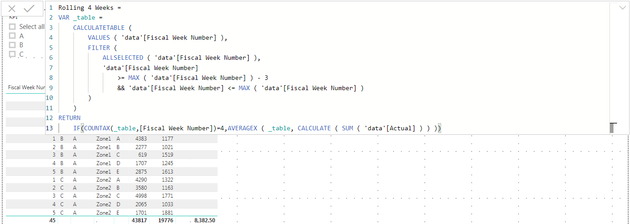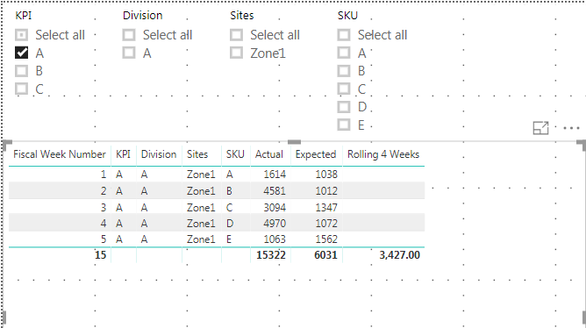FabCon is coming to Atlanta
Join us at FabCon Atlanta from March 16 - 20, 2026, for the ultimate Fabric, Power BI, AI and SQL community-led event. Save $200 with code FABCOMM.
Register now!- Power BI forums
- Get Help with Power BI
- Desktop
- Service
- Report Server
- Power Query
- Mobile Apps
- Developer
- DAX Commands and Tips
- Custom Visuals Development Discussion
- Health and Life Sciences
- Power BI Spanish forums
- Translated Spanish Desktop
- Training and Consulting
- Instructor Led Training
- Dashboard in a Day for Women, by Women
- Galleries
- Data Stories Gallery
- Themes Gallery
- Contests Gallery
- QuickViz Gallery
- Quick Measures Gallery
- Visual Calculations Gallery
- Notebook Gallery
- Translytical Task Flow Gallery
- TMDL Gallery
- R Script Showcase
- Webinars and Video Gallery
- Ideas
- Custom Visuals Ideas (read-only)
- Issues
- Issues
- Events
- Upcoming Events
Get Fabric Certified for FREE during Fabric Data Days. Don't miss your chance! Request now
- Power BI forums
- Forums
- Get Help with Power BI
- Desktop
- Calculate Dynamic Rolling 4 Week Average based on ...
- Subscribe to RSS Feed
- Mark Topic as New
- Mark Topic as Read
- Float this Topic for Current User
- Bookmark
- Subscribe
- Printer Friendly Page
- Mark as New
- Bookmark
- Subscribe
- Mute
- Subscribe to RSS Feed
- Permalink
- Report Inappropriate Content
Calculate Dynamic Rolling 4 Week Average based on multi-level category filters and using only week #
Hi All,
I'm not sure where to start with this issue. I would like to add a dynamic rolling 4 week column that changes based on the data filters.
Here is an example dataset:
| Fiscal Week Number | Actual | Expected | Division | Sites | KPI | SKU |
| 1 | 1614 | 1038 | A | Zone1 | A | A |
| 2 | 4581 | 1012 | A | Zone1 | A | B |
| 3 | 3094 | 1347 | A | Zone1 | A | C |
| 4 | 4970 | 1072 | A | Zone1 | A | D |
| 5 | 1063 | 1562 | A | Zone1 | A | E |
| 1 | 4383 | 1177 | A | Zone1 | B | A |
| 2 | 2277 | 1021 | A | Zone1 | B | B |
| 3 | 619 | 1519 | A | Zone1 | B | C |
| 4 | 1707 | 1245 | A | Zone1 | B | D |
| 5 | 2875 | 1613 | A | Zone1 | B | E |
| 1 | 4290 | 1322 | A | Zone2 | C | A |
| 2 | 3580 | 1163 | A | Zone2 | C | B |
| 3 | 4998 | 1771 | A | Zone2 | C | C |
| 4 | 2065 | 1033 | A | Zone2 | C | D |
| 5 | 1701 | 1881 | A | Zone2 | C | E |
Here are the desired results:
When I don't use any filters: (Rolling 4 week average is calculated by taking week 4 data and go back 4 weeks and average the values so (8742+8711+10438+10287)/4 = 9544.5)
| Fiscal Week Number | Sum of Actual | Rolling 4 Week Avg |
| 1 | 10287 | |
| 2 | 10438 | |
| 3 | 8711 | |
| 4 | 8742 | 9544.5 |
| 5 | 5639 | 8382.5 |
When I use one filter (Sites = Zone1)
| Fiscal Week Number | Sum of Actual | Rolling 4 Weeks |
| 1 | 5997 | |
| 2 | 6858 | |
| 3 | 3713 | |
| 4 | 6677 | 5811.25 |
| 5 | 3938 | 5296.5 |
When I use two fitlers (Sites = Zone1 and KPI = A)
| Fiscal Week Number | Sum of Actual | Rolling 4 Weeks |
| 1 | 1614 | |
| 2 | 4581 | |
| 3 | 3094 | |
| 4 | 4970 | 3564.75 |
| 5 | 1063 | 3427 |
I've added a sample .pbix file and the relevant excel for this issue.
Thanks for the help!
Solved! Go to Solution.
- Mark as New
- Bookmark
- Subscribe
- Mute
- Subscribe to RSS Feed
- Permalink
- Report Inappropriate Content
hi, @Anonymous
You could use this formula to create a measure:
Rolling 4 Weeks =
VAR _table =
CALCULATETABLE (
VALUES ( 'data'[Fiscal Week Number] ),
FILTER (
ALLSELECTED ( 'data'[Fiscal Week Number] ),
'data'[Fiscal Week Number]
>= MAX ( 'data'[Fiscal Week Number] ) - 3
&& 'data'[Fiscal Week Number] <= MAX ( 'data'[Fiscal Week Number] )
)
)
RETURN
IF(COUNTAX(_table,[Fiscal Week Number])=4,AVERAGEX ( _table, CALCULATE ( SUM ( 'data'[Actual] ) ) ))
Result:
Best Regards,
Lin
If this post helps, then please consider Accept it as the solution to help the other members find it more quickly.
- Mark as New
- Bookmark
- Subscribe
- Mute
- Subscribe to RSS Feed
- Permalink
- Report Inappropriate Content
Hello @v-lili6-msft ,
Thanks for the file. I think I know the issue. I think as soon as SKU gets introduced into the big table with everything. You won't see a Rolling 4 Weeks because there are never more than 4 weeks consecutively for SKUs.
I'll test this formula out with my real file and see if it translates over. Thanks for following up. I'll mark done as soon as I test it with my actual work file.
Thanks!
- Mark as New
- Bookmark
- Subscribe
- Mute
- Subscribe to RSS Feed
- Permalink
- Report Inappropriate Content
hi, @Anonymous
You could use this formula to create a measure:
Rolling 4 Weeks =
VAR _table =
CALCULATETABLE (
VALUES ( 'data'[Fiscal Week Number] ),
FILTER (
ALLSELECTED ( 'data'[Fiscal Week Number] ),
'data'[Fiscal Week Number]
>= MAX ( 'data'[Fiscal Week Number] ) - 3
&& 'data'[Fiscal Week Number] <= MAX ( 'data'[Fiscal Week Number] )
)
)
RETURN
IF(COUNTAX(_table,[Fiscal Week Number])=4,AVERAGEX ( _table, CALCULATE ( SUM ( 'data'[Actual] ) ) ))
Result:
Best Regards,
Lin
If this post helps, then please consider Accept it as the solution to help the other members find it more quickly.
- Mark as New
- Bookmark
- Subscribe
- Mute
- Subscribe to RSS Feed
- Permalink
- Report Inappropriate Content
HI @v-lili6-msft thank you for looking to tackle the problem. Can you attach your .pbix file with the solution? I tried using the measure you prescribed, but I wasn't able to replicate your solution that you showed in your screen shots.
- Mark as New
- Bookmark
- Subscribe
- Mute
- Subscribe to RSS Feed
- Permalink
- Report Inappropriate Content
- Mark as New
- Bookmark
- Subscribe
- Mute
- Subscribe to RSS Feed
- Permalink
- Report Inappropriate Content
Hello @v-lili6-msft ,
Thanks for the file. I think I know the issue. I think as soon as SKU gets introduced into the big table with everything. You won't see a Rolling 4 Weeks because there are never more than 4 weeks consecutively for SKUs.
I'll test this formula out with my real file and see if it translates over. Thanks for following up. I'll mark done as soon as I test it with my actual work file.
Thanks!
- Mark as New
- Bookmark
- Subscribe
- Mute
- Subscribe to RSS Feed
- Permalink
- Report Inappropriate Content
Hi,
Do you have a Date column in your dataset? If yes, then the problem becomes fairly easy to solve.
Regards,
Ashish Mathur
http://www.ashishmathur.com
https://www.linkedin.com/in/excelenthusiasts/
- Mark as New
- Bookmark
- Subscribe
- Mute
- Subscribe to RSS Feed
- Permalink
- Report Inappropriate Content
Hello there is no date column. I agree if there was a date column it would be easier to solve, but I'm only work with week numbers. I tried joining to a date table, but using the built in rolling average measure doesn't help solve the issue that comes with the multi leveled filters.
Helpful resources

Power BI Monthly Update - November 2025
Check out the November 2025 Power BI update to learn about new features.

Fabric Data Days
Advance your Data & AI career with 50 days of live learning, contests, hands-on challenges, study groups & certifications and more!

| User | Count |
|---|---|
| 103 | |
| 80 | |
| 64 | |
| 50 | |
| 45 |






